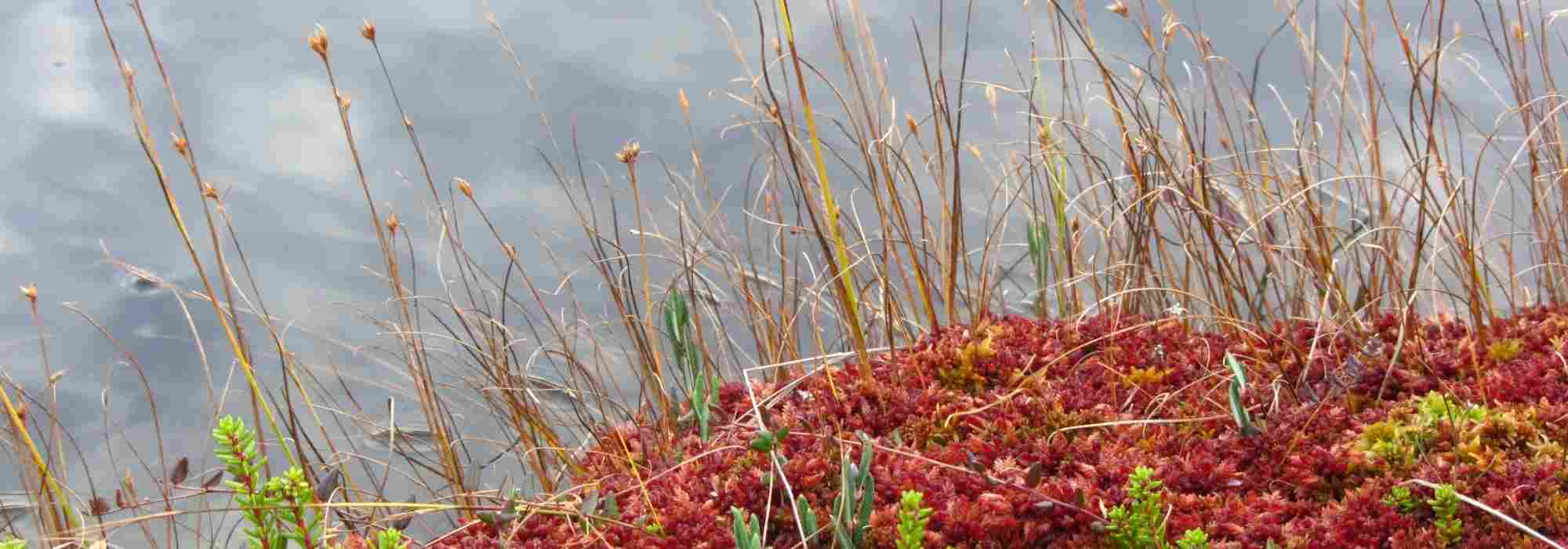
Creating a turf moor in the garden
Understanding, designing and maintaining a turf moor
Contents
The turf moor is a unique and fragile ecosystem still present in certain parts of the world. Exploited by humans for thousands of years, it serves as a colossal reservoir of carbon and biodiversity. Turf moors are famous for their diversity of carnivorous plants and other unique essential oils; this type of arrangement can be particularly original in a garden. Discover this fascinating medium and our tips for creating a mini turf moor in your garden.
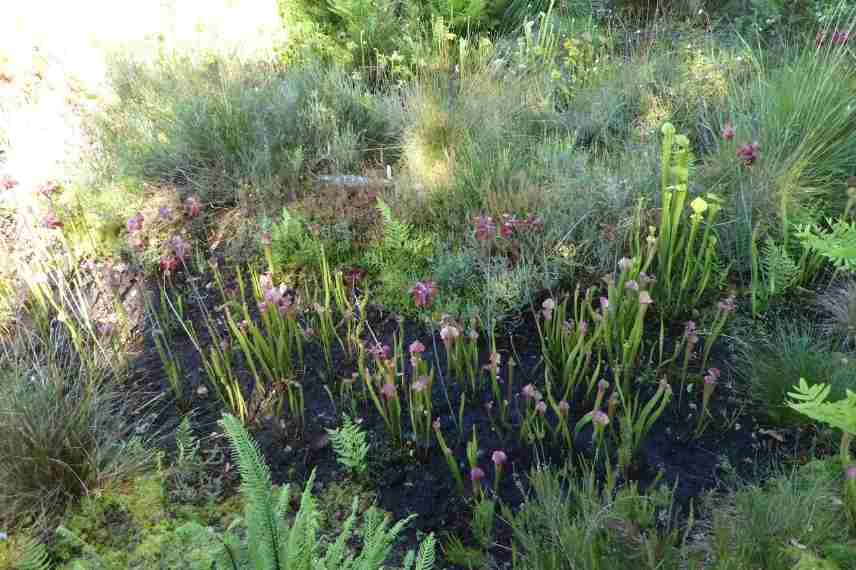
Turf moor at the Jardin des Plantes de Nantes (© Gwenaëlle David)
What is a turf moor?
Peat bogs are wetland areas characterised by the proliferation of living sphagnum (moss) which, upon dying, accumulates to form peat.
These soils, rich in water and spongy organic plant matter (little or not decomposed), typically create acidic environments. Due to the lack of oxygen and the difficulty microorganisms have in decomposing this material, it can accumulate over time to several metres!
Peatland ecosystems cover 3% to 5% of the Earth’s land surface, boasting high biodiversity and efficient carbon storage. Many plant and animal species are found only in these unique environments, which are conducive to the growth of carnivorous plants. In summary, species adapted to thrive in poor, wet conditions and harsh winter climates are found here.
The peat bog is a wet space that is unwelcoming for trees due to its lack of mineral elements and oxygen for the roots (waterlogged). These ecosystems are often exposed to full sunlight.
In the past, humans exploited peat as fuel and drained these areas, considered uncultivated, to cultivate land or plant trees.
Nowadays, these areas are protected but still face significant exploitation in some countries, particularly for the horticultural industry, which uses peat as a base for potting mixes.
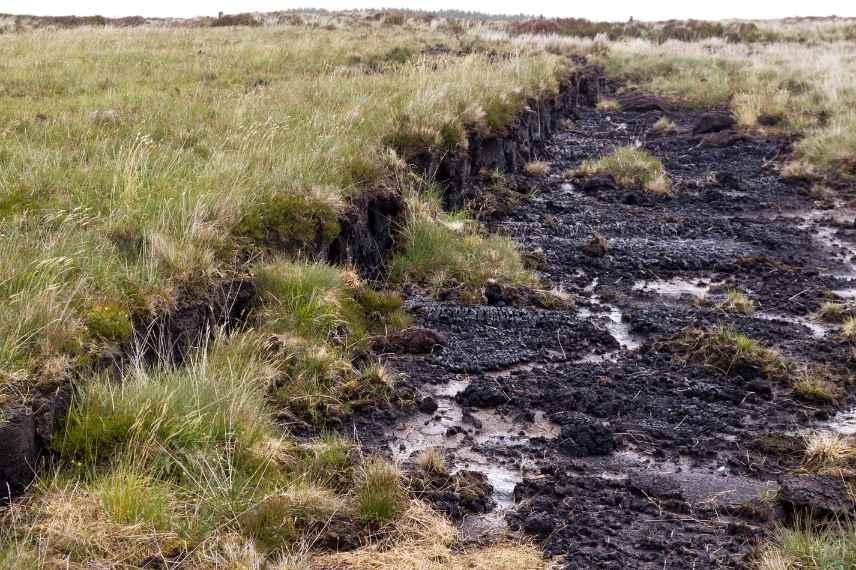
Exploited peat bog
Read also
10 perennials to grow in acidic soilWhen to create a turf moor?
The best time to create a turf moor is in spring, when the sunny days return.
Create a mini turf moor.
Choose a sunny spot sheltered from cold winds.
Creating a turf moor doesn’t require a lot of work if you opt for a container, aquarium, or planter. It will be different if you decide to create a large pit filled with peat, a setup that is both costly and not very eco-friendly given the amounts of peat needed to fill it. We suggest instead choosing a container to place on the terrace or near a patio door so you can enjoy it all year round and make your life easier. If you prefer in-ground planting, it is also possible to create a buried turf moor, but be reasonable about the size of your pit.
The materials needed to create a container turf moor
For your project, you will need:
- Blonde peat as substrate
- Perlite, sand, or expanded clay
- An aquarium, wooden container, reclaimed pallet, old planter, small preformed pond, etc.
- A waterproofing material such as a tarpaulin, liner, or any other covering to seal your container if necessary
- Turf moor plants
- A PVC pipe
- Rainwater
- A watering can
The steps to create the container turf moor
- After choosing the type of container that best suits your taste and budget, check its watertightness. Equip yourself with a tarpaulin, plastic, or any other waterproof material. Your container should be at least 50 cm high to create a larger water reserve at the bottom of your container. The greater the height, the more space the roots will have, allowing them to withstand the rigours of winter.
- Once your container is watertight, you can place your first stratum. This will consist of a material that will redistribute water by capillarity to your peat. This could be expanded clay balls, pumice, gravel, or any other element that can serve this function. Be careful not to use any calcareous material: plants from peat environments are acidophilous!
- Next, place a PVC pipe vertically, the length of which should be equivalent to the height of your container. This element will be used during watering to saturate the first stratum with water. Having the base of your container submerged will mimic a real turf moor and will also serve as a reserve (like an aquifer) in case of drought.
- Mix 70% peat and 30% perlite or sand to allow the roots to weave through more easily. Fill your container with this mixture. While filling, compact your substrate and saturate it with water: since peat is very fluffy, it will need to be saturated and compacted to mimic the natural conditions of its original environment.
- Fill your container to the brim, ensuring one end of the PVC pipe is flush with the surface.
- We can now move on to the most enjoyable step: planting.
Planting turf moor plants
There are dozens of species to introduce in this type of arrangement. Sphagnum will remain THE essential plant to include in your project as it is the foundation of this ecosystem. Place it in a small hollow created with the palm of your hand and water it abundantly during the first few weeks… success guaranteed! The mat formed by this curious moss will protect the rest of this micro habitat during the long winter months.
Drosera is an iconic turf moor plant. You will also find cotton grasses, cranberries, or even Sarracenia, Venus flytrap, or Darlingtonia, which are very popular in this type of micro habitat. It is also possible to integrate small carex or molinia.
Small trees like dwarf birch or creeping willow can also be added for larger projects.
Most of these plants (including the carnivorous ones) appreciate companionship with sphagnum (in particular) and do not require large planting distances between each clump as they grow slowly. However, Drosera should be monitored closely as they are very small and could be overshadowed by the others.
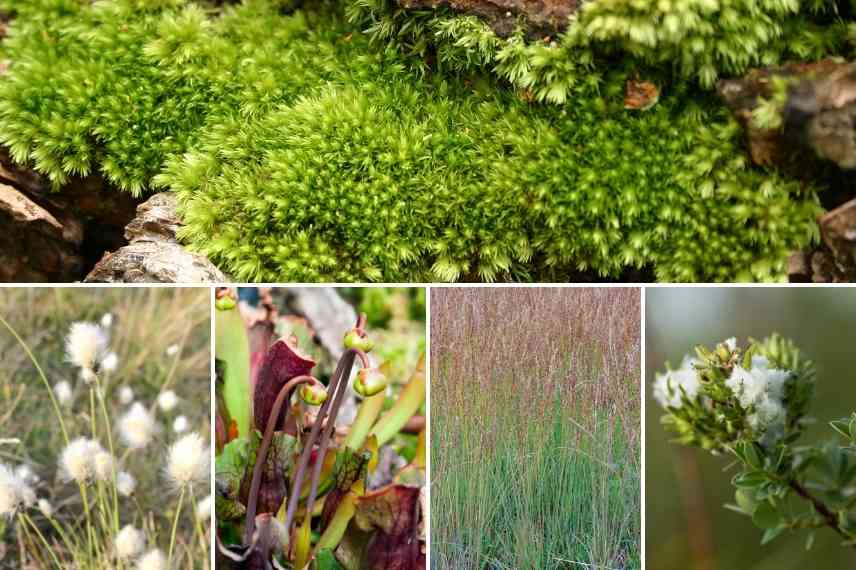
Sphagnum, Cotton grasses, Molinia caerulea ‘Moorhexe’ and Salix repens
The important thing is to fill the planting surface well to create a natural effect quickly.
Also, try to group the species together and avoid mixing everything. This does not look good visually and will complicate the maintenance of your project.
Don’t forget to adapt your plants to your climate! If you are lucky enough to live near a turf moor, why not visit to identify the plants to adapt at home?
In terms of maintenance, the main focus should be on maintaining a constant and significant humidity. Be careful with small-growing plants that should not be outcompeted.
→ Discover our video on Sarracenias
And a turf moor integrated into your natural pond?
If you already have a natural pond, it is entirely possible to dedicate a corner of it to the theme of the turf moor.
Separate it from the rest of the pond with some stone blocks (non-calcareous) or any other obstacle that can retain the blonde turf and plant your vegetation there.
Turf has a buffering effect on the pH of your pond and hosts a variety of beneficial purifying bacteria that are advantageous for the water in your pond!
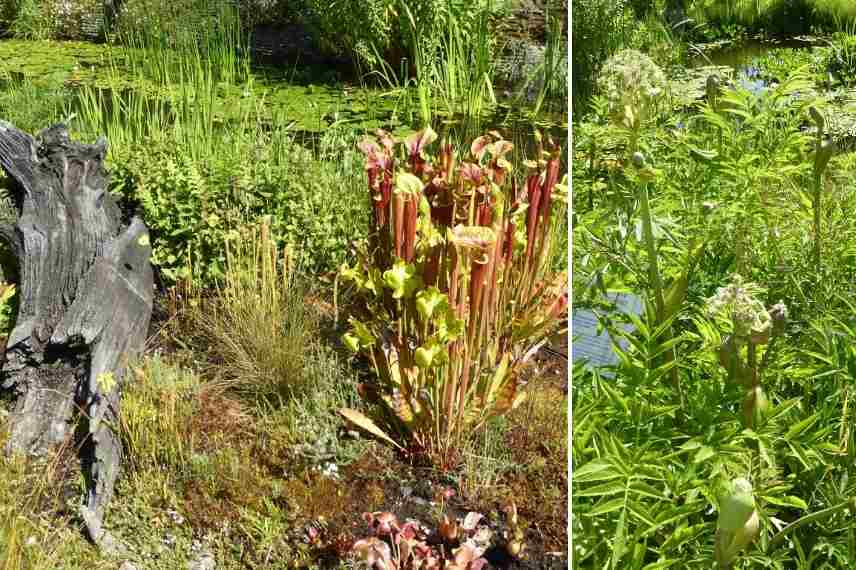
Turf moor at the Jardin des Plantes in Nantes, on the right Angelica heterocarpa ‘Lloyd’ (© Gwenaëlle David)
- Subscribe!
- Contents
![[tourbière titre="Créer une tourbière"]
Pour créer une tourbière dans votre jardin, suivez ces étapes simples :
1. **Choisir l'emplacement** : Sélectionnez un endroit ensoleillé ou partiellement ombragé pour votre tourbière.
2. **Préparer le sol** : Creusez un trou d'environ 30 cm de profondeur et retirez les mauvaises herbes. Ajoutez un mélange de terre de bruyère et de sable pour assurer un bon drainage.
3. **Choisir les plantes** : Optez pour des plantes adaptées aux tourbières comme les sarracénias, les droseras, les utriculaires et les callunes.
4. **Planter les plantes** : Disposez les plantes dans le trou en prenant soin de respecter les espacements recommandés.
5. **Arroser régulièrement** : Maintenez le sol humide en arrosant régulièrement, mais évitez l'engorgement.
6. **Entretenir la tourbière** : Retirez les fleurs fanées et les feuilles mortes pour encourager la croissance des plantes.
7. **Profiter de votre tourbière** : Admirez la beauté et la diversité des plantes qui s'épanouissent dans votre tourbière.
N'hésitez pas à expérimenter avec différentes espèces de plantes pour créer une tourbière unique et attrayante dans votre jardin.
[/tourbière]](https://en.promessedefleurs.eu/blogwp/wp-content/uploads/2021/07/Creer-une-tourbiere.jpg)































Comments